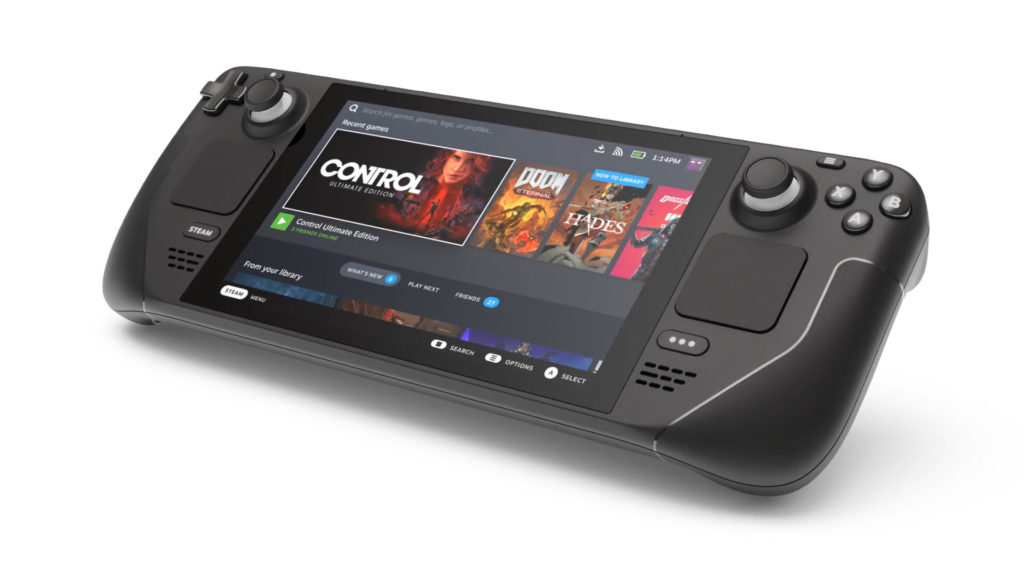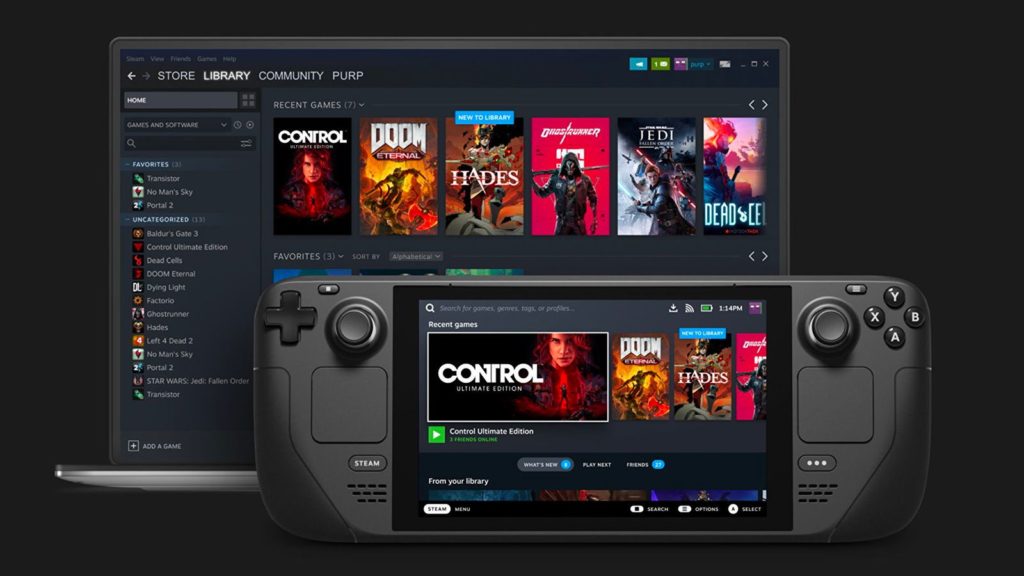The Aya Neo Next has been making some splashes in the handheld community as a potential “Steam Deck killer”. Here’s the differences between the Aya Neo Next and Steam Deck in terms of specifications, along with why you might want to opt for one over the other.
Steam Deck Specs

To start, the Steam Deck, which releases on February 25, offers users an APU that functions on AMD’s Zen 2 architecture. Its an 4-core processor that caps out at 3.5GHz, and can most closely related to the 3000 series of AMD desktop CPUs on the market today, which also function on Zen 2. Despite this relation, there isn’t a direct comparison that one could make towards any other CPU.
As for the graphical processing power inside the APU, the Steam Deck is, again, using AMD technology by placing an RDNA 2 GPU into its system-on-chip hardware that sports up to 1.6 TFLOPS, or about a third of what the GTX 1060 can handle. But being a custom part, the Steam Deck’s GPU doesn’t have a comparison in today’s market, and Valve’s use of SteamOS to minimise overheads makes direct parallels difficult to draw.
Because an APU doesn’t have access to dedicated, separate RAM for its graphical processing like a dedicated GPU does, the RAM inside the Steam Deck is mightily important. This is why users are looking forward to testing out the 16GB of LPDDR5 RAM clocked at 5500MHz alongside its other components. All the same, the RAM inside the Steam Deck should support its components reasonably well, with early testing showing promising FPS results across a multitude of games.
The Steam Deck also features a 7-inch touch display with a resolution of 1280 x 800p set at a refresh rate of 60Hz, alongside various levels of storage across different price points, capping out at $649 for a 512GB NVMe SSD. All versions of the Steam Deck have an optional microSD slot for additional storage, although no microSD can come close to matching the internal NVMe SSD’s bandwidth (or a regular SSD for that matter).
The joysticks that make the primary control scheme for the Steam Deck are also complimented by the console standard ABXY diamond button scheme, two bumpers, two triggers and two touch pads, which should make games with complicated UIs easier to manage. (Looking at you, Stellaris and Crusader Kings.)
Priced between $399 to $649, the Steam Deck’s biggest strength is that it can offer users reasonable performance across a large variety of games at extremely competitive prices. That pricing strength of the Steam Deck is likely what’s going to drive most users to the Steam Deck over the Aya Neo Next, which offers similar features but for over double the price.
Aya Neo Next Specs

The Aya Neo Next is a sequel to the Aya Neo, a crowdsourced handheld gaming device that was inspired by the Nintendo Switch. If there’s a way to encapsulate what the Ayo Neo Next is all about, you can do it by thinking “power and price”. Both, in relation to other handheld devices, are high.
This mantra is being taken a step further with upgrades to the Aya Neo Next’s CPU and GPU over its previous iteration. The Aya Neo Next sports a Ryzen 7 5800U APU, a full generational upgrade over its previous incarnation. The 5800U features 8 cores clocked at 4.2GHz, and is built on Zen 3 architecture. Unlike the Steam Deck’s APU, the 5800U is an off-the-shelf component. It’s hard enough third-party testing that it should have no trouble outpacing the Steam Deck’s in-house Zen 2 offering, at least in terms of raw computing power.
Vega 8 powers the Aya Neo Next’s on-board graphics, AMD’s second best APU solution, right behind Vega 11. But despite being an older part, the Vega 8 has had extensive testing and is capable of enough of hitting 60+ fps in most modern titles with the right CPU.
To compliment the on-board graphics, the Aya Neo Next has 16GB LPDDR4X RAM clocked at 4266MHz. The kicker here is that we don’t know the timings for Aya Neo Next’s LPDDR4X RAM. Faster DDR4 RAM still outperforms DDR5 equivalents in some video games today, with older titles specifically .
The Aya Neo Next has a 1280 x 800 resolution 7-inch display locked at a refresh rate of 60Hz, which makes it identical to the Steam Deck in terms of parameters. It also features customizations for storage, including the ability to upgrade to 2TB of PCIe NVMe SSD storage.
Without touch pads to compliment the joystick controls, the Aya Neo Next loses some of the convenience that Steam Deck users are going to enjoy. Aside from that, this expensive handheld PC features the same two trigger, two bumper, and diamond ABXY button layout that the Steam Deck offers.
The fact that the similarities between the Steam Deck and Aya Neo Next stop only with slight variances in hardware and layout have been making users scratch their heads as they look at the price differences between the two systems, as the Aya Neo Next has an MSRP of $1315, nearly twice the price of the Steam Deck’s most expensive model. The performance of the former certainly doesn’t represent a double in gaming potential, yet the price of the Aya Neo Next seems to reflect it. This is likely due to Ayaneo, as a manufacturer, not being able to command the same economies of scale as Valve.
Steam Deck vs. Aya Neo Next: Which should you get?

On paper, the Aya Neo Next seems to be doing everything bigger than the Steam Deck, but not necessarily more efficiently. The Aya Neo Next wins out in CPU power, storage, and comes with the Windows operating system, which immediately makes it more applicable for everyday use aside from just gaming.
The Steam Deck has a significantly weaker CPU, but with a GPU that’s not only speculatively equal or stronger in terms of power to the Vega 8 solution, but designed specifically for the Steam Deck, whether or not the weaker CPU comes to pass as something that matters at all in terms of effective gaming performance between the Steam Deck and Aya Neo Next remains to be seen.

In terms of on-paper performance, the Aya Neo Next will likely beat the Steam Deck in most games, especially ones that are CPU bound. But because the Steam Deck is running on a Linux OS, is officially compatible with thousands of Steam games, and is almost $1000 cheaper than the Aya Neo Next, it’s likely to be more successful. The Deck is more affordable, more lightweight and as a base device means that the Steam Deck is going to be far more lightweight, gaming-focused, and will pack a far greater price to performance punch. So which should you choose?
If you want a potentially faster device with more built-in storage and you’re happy to pay the premium, the Aya Neo Next is a decent alternative to the Steam Deck. If you want a good hand-held gaming device with a large catalogue of games for a reasonable price alongside in house hardware maximized for efficiency, Steam Deck all the way.












Published: Feb 1, 2022 01:00 am